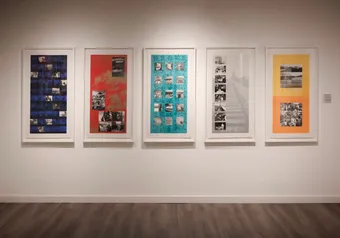Persistence of Vision is a short film festival showcasing the works of third- and fourth-year students in UBC’s Department of Theatre and Film. This year's lineup had no two films that were alike, showcasing diversity in technique, character and storyline.
Violet and June
The night's opening film was Violet and June. Violet falls in love with her best friend June and has to come up with the courage to tell her. The story was a simple one of young, innocent love — seamlessly mixing childlike flirtation with an existential crisis. What the film lacked in flashy production it made up for in heart. It was impossible to dislike and you couldn’t help but smile.
The Talisman
The Talisman was one of the most ambitious films of the night and unfortunately it was unable to fit that ambition into its 10-minute run time. The plot was unclear, due to the fact that much of the dialogue was devoted to explaining the fantasy world within which the film took place, with only two minutes being used for a mediocre fight scene. Ultimately, the short run time was not enough to showcase a story which should have taken two hours.
Love Bites
Love Bites was a fun vampire love story which got a good laugh out of the audience. It’s slapstick comedy and awkward first-date clichés were endearing. However, the film would have benefited from dialogue (it had almost none) and a discernible plot that consisted of more than a young vampire couple walking around aesthetically pleasing date sites and running away from anti-vampire paraphernalia.
Roundhouse
Roundhouse told the story of a young woman who is made to choose between her culture and the adventure of her formative teen years. The simple plot was enhanced by lead actress Rikki Lyn Ward’s wonderful performance and a stunning combination of visuals and sound. The beautifully filmed, directed and acted dream state in the second half of the film provided a satisfying end to a familiar story.
Here There be Tygers
Based on the 1968 short story by Stephen King, Here There be Tygers demonstrated the patronization faced by young children from adults, tied in with a childhood fantasy of a lurking tiger within an elementary school bathroom. The presence of this tiger, as well as the sour teacher back in the classroom, gave the child protagonist no place to be safe, perhaps serving as a metaphor for mental illness. The most noteworthy elements of the film were its sound and camerawork, both of which were awkward, uncomfortable and claustrophobic. This was by no means a flaw, but instead an effective technique to create a tense, creepy atmosphere.
The Supreme Leader’s New Clothes
The Supreme Leader’s New Clothes would have served very nicely as a trailer for a period piece, feature length film. The story – though it wasn’t particularly clear – consisted of a man being freed from a North Korean prison camp and being given a new set of white clothes in the process. It was the only film of the night to not use any dialogue whatsoever and was gracefully presented in a white, monochromatic style. While the use of music as a substitute for dialogue was a nice touch, some narration may have allowed for a clearer, more focused plot.
The Firm
The Firm was one of the night's most story-driven films, portraying a nine-to-five office worker whose dissatisfaction leads him to resign after a promotion. We're shown the lack of meaning behind corporate professions and the toll it takes on the psyche. As the protagonist realizes that his job has little meaning, he adopts a devil-may-care attitude, including smoking copious amounts of pot (someone watched American Beauty recently). The Firm was able to express its themes and deeper meanings through a fast pace and strategic use of camera techniques, which concluded with a fitting, albeit bleak, resolution.
Softcore
Softcore showed a night in the life of a young woman who attempts to run away after getting in a fight with her mother. The opening shot of the mother and daughter fighting through their kitchen window was effective at setting the scene, but the film lost credibility later on due to how it dealt with its theme of avoiding pain, using conspicuous dialogue and other elements that made it seem overly confident.
La Mariposa
La Mariposa was one of many stories that felt undeniably Canadian. A young girl's repeated attempts to learn how to swim stand in for her family’s struggle to create a new life in Canada. With the majority of the dialogue spoken in Spanish, this story of heartwarming earnestness had a happy ending that put a well-deserved smile on the face of the viewer.
The Fall of Dad
The Fall of Dad was the first film to be presented after the intermission, during which the hosts warned the audience that the second half of the festival would contain adult content. This film did not disappoint, presenting a worst-case-scenario story of a one-night-stand. The film got a laugh out of the audience, its humour being compensation for its simple production and storyline.
Unravel
Unravel was one of my favourite films of the night, both in its storytelling and visual aesthetic. The plot followed two people who hook up over their shared belief in chemtrails and other conspiracy theories. The film neither glamorized nor demonized the two main characters and the audience was able to read their feelings with minimal dialogue. Particularly outstanding was the style of the film, which made use of home-movie camera techniques that felt reminiscent of the Zapruder film and footage of the Challenger Disaster. The film’s ending may be up for interpretation, but what I gathered was “trust no one.”
HAXX Deadroom
HAXX Deadroom was a clear audience favourite. This piece had one of the most fully illustrated plot lines, featuring a beginning middle and end, hero, villain and climax. It was reminiscent of one of the more gruesome episodes of Black Mirror and mixed nostalgia with modern day apocalypse fiction. The film was fully aware of its existence as a short film and had no expository dialogue or loose endings, successfully telling an entire story within 15 minutes.
Daughters
Daughters successfully tricked the audience by first telling an uncomfortable story about a man with cruel intentions and then – after the majority of the film’s tense events – pulling the rug out from under our feet with a sympathy-for-the-devil resolution. In this case, the uncertain ending was a benefit that tests the audience's own assumptions.
Journey of a Thousand Smiles
Journey of a Thousand Smiles seemed as though it was made by someone who wasn’t actually a part of the POV festival and had nothing to lose or gain, putting together a short film just to get a laugh out of the audience. The plot consisted of a trio, then quartet, of oddball characters trying to find Heaven, which consisted of a man (God) wearing a extremely artificial costume standing in front of a green-screened cloud background. Unfortunately, the film was not even technically satisfactory, bringing its level of “comedy” down entirely.
The Wages
The Wages was one of the most dialogue-heavy films of the night, as most of the plot progressed through discussion between characters instead of through their actions. There was a great deal of tension building and character development for a scene consisting of two men in armchairs talking about nothing in particular. With a plot similar to Manchester By the Sea, this short film could easily be transformed into a feature length film with massive success.
The Devil and the Frog Mountain
I’m not against weirdness in film. I believe twisted plots that force the viewer to think about what they've watched hours after it has ended are an effective way of creating a lasting impact. To put it simply, The Devil and the Frog Mountain was weird. A young couple try to ensure the health of their unborn child by depriving the wife of eating and providing overly bizarre offerings to unknown beings.
The majority of the film serves as a metaphor for the physical and mental sacrifices experienced by women, which was made especially powerful through the superb acting by the two leads. However, the film had a bizarrely unexplained ending, with supernatural creatures appearing suddenly with no proper explanation or resolution. This gave the film the appearance of being “weird for weirdness' sake.” In other words, if it’s going to be weird it should probably tie up loose ends to avoid excessive ambiguity.
Bag Head
The major strength of Bag Head was its ability to reveal the background conflict and character motivations in its run time, without exaggerated exposition. Two men interrogate another with a bag over his head after getting back the car that he stole. With quick dialogue and interesting camerawork, this story of a criminal with a good heart could easily be seen in theatres worldwide.
The Good Fight
The Good Fight won me over with its exceptional camera work, demonstrating a perfect knowledge of how close we should be to certain characters and how long certain shots should last. The story was about a young postulant who gives in to temptation and must face unspoken consequences from her superiors. The film was mischievous and gave the impression that the audience was in on a secret. You couldn't help but have immense sympathy for the protagonist.
Methodic
Methodic was the story of an actor who is paranoid about the supposed infidelity of his wife. Throughout the film the audience is never fully sure of what is real and what is imagined by the protagonist and the film's end left us feeling uncertain. The fast pace of the film and use of light and shadows gave us a visual representation of the protagonist’s inner conflict and divisiveness.
First online
Share this article



![['']](https://storage.googleapis.com/ubyssey/media/renditions/LoveBites-Director.width-1000.format-webp.webp)
![['']](https://storage.googleapis.com/ubyssey/media/renditions/pov2.width-1000.format-webp.webp)
![['']](https://storage.googleapis.com/ubyssey/media/renditions/AnnforMetro-155.width-1000.format-webp.webp)
![['']](https://storage.googleapis.com/ubyssey/media/renditions/pov3.width-1000.format-webp.webp)
![['']](https://storage.googleapis.com/ubyssey/media/renditions/BTS3.width-1000.format-webp.webp)
![['']](https://storage.googleapis.com/ubyssey/media/renditions/AnnforMetro-205.width-1000.format-webp.webp)





